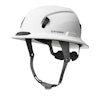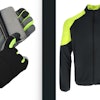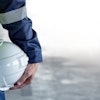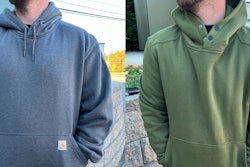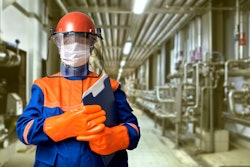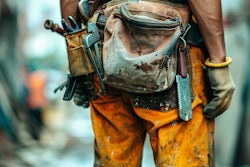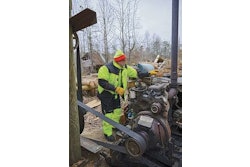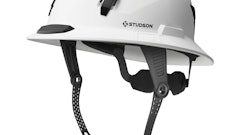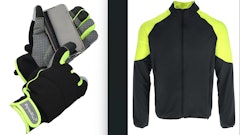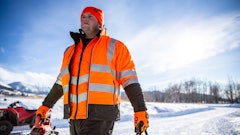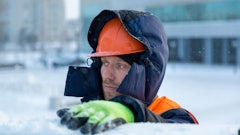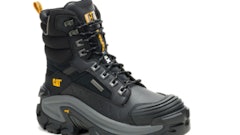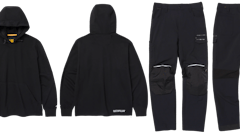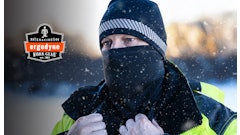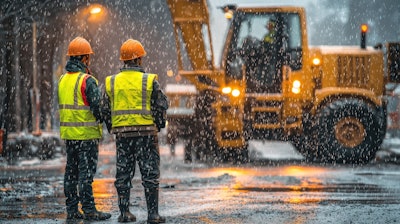
As changing seasons sometimes brings harsh weather conditions, construction workers brave the elements by wearing apparel that will help them navigate through wet conditions without sacrificing comfort, safety, health, and productivity.
Outdoor working conditions exposing a worker to rain or snow may necessitate wearing water-resistant or waterproof construction clothes.
There’s a distinction: waterproof apparel is designed to keep water out entirely. Water-resistant apparel repels water to a certain degree, but may not be entirely waterproof.
Many waterproof materials also are windproof.
Waterproof apparel can be manufactured from synthetic materials such as polyester or nylon or natural materials such as rubber or waxed cotton.
Waterproof materials include polyester, nylon, and rubber. GORE-TEX is a membrane often used to make waterproof clothing. It’s a breathable material that allows sweat to evaporate.
As this story in IRONPROS notes, wearing waterproof workwear to stay dry also takes into account other factors, such as breathability and moderate to light insulation for comfort.
Waterproofing is measured by a hydrostatic head test and measured in millimeters (mm).
- 0-5,000 mm indicates no to some resistance to moisture in conditions of light rain and dry snow.
- 6,000-10,000 mm indicates rainproof and waterproof under light pressure in conditions of light rain and average snow.
- 11,000-15,000 mm indicates rainproof and waterproof except under high pressure in conditions of moderate rain and average snow.
- 16,000-20,000 mm indicates rainproof and waterproof under high pressure in conditions of heavy rain and wet snow.
- A measure of more than 20,000 mm indicates rainproof and waterproof under very high pressure in conditions of heavy rain and wet snow.
Manufacturers typically describe the waterproof and breathability ratings of fabrics using two numbers, often separated by a backslash. The first number is waterproof, the second is breathability (with higher numbers indicating higher breathability).
Waterproof construction apparel – including a hooded jacket, pants, head-to-toe rainsuit, socks, and gloves – helps keep a worker dryer for longer periods of time in inclement weather. Workers should ensure hard hats are designed to handle the elements.
Ensure that waterproof jackets and vests also offer high visibility so that workers are seen on the site.
Waterproof work clothing may provide protection from electrical hazards. Consider also the need for flame resistance.
Gloves made of materials such as neoprene or GORE-TEX that are waterproof or water resistant and insulated help keep the hands warm and offer a better grip of tools.
In addition to considering waterproof jackets, this story notes the benefits of a waterproof hoodie in contrast to a long-sleeve shirt. Waterproof hoodies can be less restrictive in terms of body movement if they are to be worn instead of other rain gear options.
Rain or rubber boots are designed with waterproof technology that keeps feet dry and reduces the potential for slipping. Considerations include composite toe caps, steel toes, puncture-resistant soles, electrical hazard protection, puncture-resistant safety features, or slip-resistant outsoles.
Look for rubber boots with a good sole that provide a firm grip on surfaces. Anti-skid technology is another key safety component. Boots designed with deep treads or lugs may help prevent slips and falls.
The choice of socks is essential.
Elizabeth Scheiber, DPM, Department of Orthopaedic Surgery, Cleveland Clinic Weston (Florida) Hospital, pointed out wearing wet socks can lead to fungal infections. She said to avoid 100 percent cotton socks and opt for antimicrobial merino wool, small fiber wool, bamboo or acrylic synthetic blends like polyester or nylon.
If construction workwear isn’t designed to be waterproof, a spray can be used to waterproof it as noted in this story. If the apparel has a DWR (Durable Water Repellent) rating, additional waterproofing may not be necessary.
Waterproofing product options on the market include wax-based solutions, sprays, and wash-in solutions.
The application of some waterproofing sprays may compromise breathability. Optimal waterproofing spray for garments does not create a complete seal but rather remains semi-porous to allow the material to be breathable and not trap moisture.
Waterproofing effectiveness can wane over time.
When in doubt about the appropriate apparel to wear on the construction site, consult with the construction site’s safety manager to ensure there is no violation of American National Standards Institute, Occupational Safety and Health Administration, and National Fire Protection Association safety standards.

